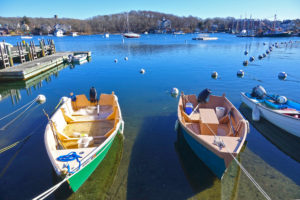Falmouth is the second-largest municipality on Cape Cod, next to Barnstable. With its many inlets, bays, harbors, and ponds, it can be a wonderful place of discovery for the naturalist, artist, photographer, runner, and visitor. It’s well known for its beautiful beaches, its villages, and as a home to the Steamship Authority terminal that provides access to Martha’s Vineyard. Here’s a little more information you might not know.
Falmouth is home to the Woods Hole Oceanographic Institution (WHOI), the Marine Biological Laboratory (MBL), the Woods Hole Research Center, NOAA’s Woods Hole Science Aquarium, and the scientific institutions’ various museums. These organizations study and research all aspects of marine science and engineering.
Built by the Beebe family of Boston in 1878, Highfield Hall was one of the early summer mansions to grace Cape Cod and is one of the few remaining examples of Stick-style Queen Anne architecture in the Northeast. Following its complete restoration between 2001 and 2006, and its grand reopening, Highfield Hall has welcomed more than 125,000 visitors, and is a place of music, arts and events.
Katharine Lee Bates was born in Falmouth, the daughter of Congregational pastor William Bates and his wife, Cornelia Frances Lee. She is famously known as an author and poet, and wrote the song, “American the Beautiful.” Bates died in Wellesley, Massachusetts, on Sept. 28, 1929, and is buried in Oak Grove Cemetery, in Falmouth. There is a statue of her on the Public Library lawn.
The Town of Falmouth has seven historic districts, including four on the National Register of Historic Places: Falmouth Village Green, North Falmouth Village, Waquoit and West Falmouth Village. The other three historic districts are in Woods Hole, Davisville, and Quissett.
The Nobska Point Lighthouse in Woods Hole offers panoramic views of Vineyard Sound, the Elizabeth Islands, and Martha’s Vineyard. The “keeper’s dwelling” was home to the commander of the southeastern sector of the New England Coast Guard for years. It is now owned by the Town of Falmouth and preserved by The Friends of Nobska Light. The lighthouse station was established in1829, the present tower was built in 1876 and the lighthouse was automated in 1985.
Sept. 1, 1985, was the date on which the wreck of RMS Titanic was located – the result of a joint French-American expedition headed up by Jean-Louis Michel of the French National Institute of Oceanography (IFREMER) and Robert Ballard of the Woods Hole Oceanographic Institution (WHOI), in Falmouth. In August and September of 2010, the first complete picture of the Titanic wreckage was produced by the WHOI.
The Northeast Fisheries Sciences Center (NEFSC) is the nation’s original federal fisheries laboratory, established in Falmouth in 1871. Research supports efforts to build sustainable marine fisheries, move to ecosystem-based fishery management, and to recover endangered marine mammals, fish, and sea turtles. The lab also conducts large-scale ocean and fishery monitoring. Its Woods Hole Science Aquarium is the nation’s oldest public aquarium, open to visitors year-round.


























